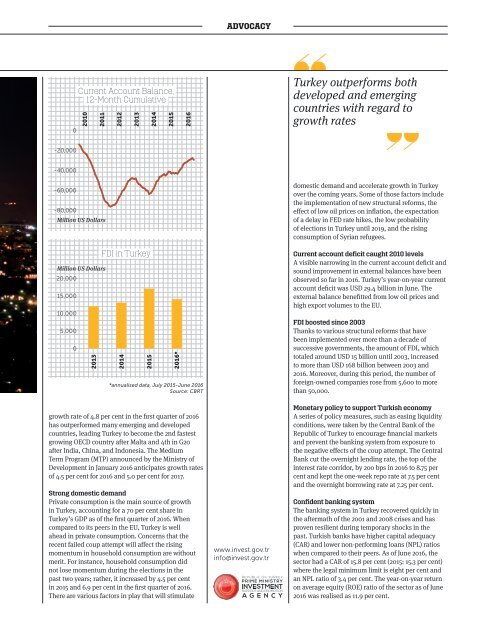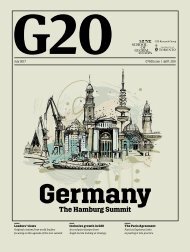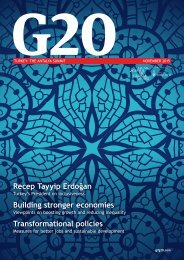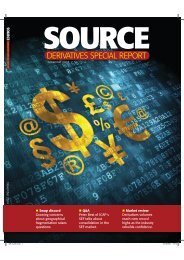G20 china_web
You also want an ePaper? Increase the reach of your titles
YUMPU automatically turns print PDFs into web optimized ePapers that Google loves.
0<br />
-20,000<br />
-40,000<br />
-60,000<br />
-80,000<br />
20,000<br />
15,000<br />
10,000<br />
5,000<br />
012+13+17+14<br />
Current Account Balance,<br />
12-Month Cumulative<br />
2010<br />
2011<br />
Million US Dollars<br />
Million US Dollars<br />
2013<br />
2012<br />
2013<br />
FDI in Turkey<br />
2014<br />
2015<br />
2014<br />
2015<br />
2016*<br />
2016<br />
*annualised data, July 2015-June 2016<br />
Source: CBRT<br />
growth rate of 4.8 per cent in the first quarter of 2016<br />
has outperformed many emerging and developed<br />
countries, leading Turkey to become the 2nd fastest<br />
growing OECD country after Malta and 4th in <strong>G20</strong><br />
after India, China, and Indonesia. The Medium<br />
Term Program (MTP) announced by the Ministry of<br />
Development in January 2016 anticipates growth rates<br />
of 4.5 per cent for 2016 and 5.0 per cent for 2017.<br />
Strong domestic demand<br />
Private consumption is the main source of growth<br />
in Turkey, accounting for a 70 per cent share in<br />
Turkey’s GDP as of the first quarter of 2016. When<br />
compared to its peers in the EU, Turkey is well<br />
ahead in private consumption. Concerns that the<br />
recent failed coup attempt will affect the rising<br />
momentum in household consumption are without<br />
merit. For instance, household consumption did<br />
not lose momentum during the elections in the<br />
past two years; rather, it increased by 4.5 per cent<br />
in 2015 and 6.9 per cent in the first quarter of 2016.<br />
There are various factors in play that will stimulate<br />
ADVOCACY<br />
www.invest.gov.tr<br />
info@invest.gov.tr<br />
Turkey outperforms both<br />
developed and emerging<br />
countries with regard to<br />
growth rates<br />
domestic demand and accelerate growth in Turkey<br />
over the coming years. Some of those factors include<br />
the implementation of new structural reforms, the<br />
effect of low oil prices on inflation, the expectation<br />
of a delay in FED rate hikes, the low probability<br />
of elections in Turkey until 2019, and the rising<br />
consumption of Syrian refugees.<br />
Current account deficit caught 2010 levels<br />
A visible narrowing in the current account deficit and<br />
sound improvement in external balances have been<br />
observed so far in 2016. Turkey’s year-on-year current<br />
account deficit was USD 29.4 billion in June. The<br />
external balance benefitted from low oil prices and<br />
high export volumes to the EU.<br />
FDI boosted since 2003<br />
Thanks to various structural reforms that have<br />
been implemented over more than a decade of<br />
successive governments, the amount of FDI, which<br />
totaled around USD 15 billion until 2003, increased<br />
to more than USD 168 billion between 2003 and<br />
2016. Moreover, during this period, the number of<br />
foreign-owned companies rose from 5,600 to more<br />
than 50,000.<br />
Monetary policy to support Turkish economy<br />
A series of policy measures, such as easing liquidity<br />
conditions, were taken by the Central Bank of the<br />
Republic of Turkey to encourage financial markets<br />
and prevent the banking system from exposure to<br />
the negative effects of the coup attempt. The Central<br />
Bank cut the overnight lending rate, the top of the<br />
interest rate corridor, by 200 bps in 2016 to 8.75 per<br />
cent and kept the one-week repo rate at 7.5 per cent<br />
and the overnight borrowing rate at 7.25 per cent.<br />
Confident banking system<br />
The banking system in Turkey recovered quickly in<br />
the aftermath of the 2001 and 2008 crises and has<br />
proven resilient during temporary shocks in the<br />
past. Turkish banks have higher capital adequacy<br />
(CAR) and lower non-performing loans (NPL) ratios<br />
when compared to their peers. As of June 2016, the<br />
sector had a CAR of 15.8 per cent (2015: 15.3 per cent)<br />
where the legal minimum limit is eight per cent and<br />
an NPL ratio of 3.4 per cent. The year-on-year return<br />
on average equity (ROE) ratio of the sector as of June<br />
2016 was realised as 11.9 per cent.
















